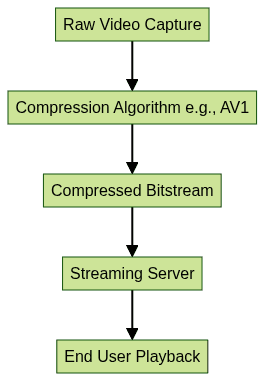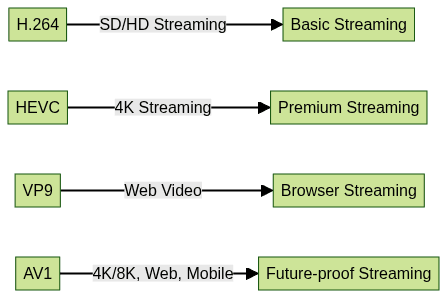AV1 Compression: The Next-Gen Video Codec for Efficient Streaming
Introduction to AV1 Compression
In the era of 4K and 8K video streaming, efficient video compression has never been more critical. AV1 compression, developed by the Alliance for Open Media (AOMedia), represents a quantum leap for video delivery in 2025. As a royalty-free, open-source video codec, AV1 is engineered to offer superior compression efficiency, enabling content providers to deliver high-quality streams using less bandwidth. This is especially vital as global internet usage skyrockets and video-on-demand becomes the norm.
AV1 compression stands out by balancing video quality with reduced file sizes, making it ideal for both real-time streaming and offline playback. Its adoption is accelerating across browsers, streaming services, and hardware platforms, promising a future where high-quality video is accessible to all, regardless of device or connection speed.
The Evolution of Video Compression
The Need for Efficient Video Codecs
The demand for high-resolution content is surging—users expect seamless 4K and even 8K streaming with minimal buffering. However, raw video files are massive, putting immense pressure on bandwidth and storage infrastructure. Efficient video codecs are essential to compress these files while preserving visual fidelity, ensuring scalable video delivery for platforms like YouTube, Netflix, and Twitch. For developers building real-time communication platforms, integrating a robust
Video Calling API
can further optimize bandwidth usage and enhance user experience.From Raw Video to Compressed Streams
To illustrate the impact of compression, consider a simple size calculation:
1# Calculate raw video size (uncompressed)
2width = 1920 # Full HD
3height = 1080
4fps = 30
5seconds = 60 # 1 minute video
6channels = 3 # RGB
7bits_per_channel = 8
8
9raw_size_bytes = width * height * fps * seconds * channels * (bits_per_channel // 8)
10raw_size_gb = raw_size_bytes / (1024 ** 3)
11print(f"Raw 1-minute Full HD video size: {raw_size_gb:.2f} GB")
12A one-minute Full HD video can easily exceed 10 GB uncompressed! Compression algorithms like AV1 dramatically reduce this size, making streaming feasible for users worldwide. If you're building browser-based communication tools, leveraging a
javascript video and audio calling sdk
can help you deliver seamless, high-quality calls with efficient bandwidth usage.Visualizing the data flow:

What is AV1 Compression?
Origins and Development
AV1 compression is the result of a collaborative effort by the Alliance for Open Media, a consortium that includes tech giants such as Google, Mozilla, Microsoft, Amazon, Netflix, and others. Their goal: to create a next-generation, open-source video codec that outperforms existing standards in efficiency and accessibility. AV1 is the direct successor to VP9 and builds on years of research in video compression science. As AV1 becomes more prevalent, developers working on mobile platforms can also explore solutions like
webrtc android
to enable real-time video communication with advanced compression.AV1’s Royalty-Free Model
Unlike HEVC (H.265), which is encumbered by complex licensing fees, AV1 is royalty-free. This model has accelerated its adoption in open-source projects and commercial software alike, lowering the barrier for innovation in video delivery. Developers and companies can implement AV1 without legal or financial hurdles, enabling a broader ecosystem of streaming platforms, media players, and hardware solutions. For cross-platform development, frameworks such as
flutter webrtc
are making it easier to integrate real-time video features with next-gen codecs like AV1.Key Features and Advantages of AV1 Compression
Compression Efficiency and Quality
AV1 is engineered for maximum compression efficiency. When compared to legacy codecs like H.264 (AVC) or even more recent ones like HEVC and VP9, AV1 consistently delivers higher quality at lower bitrates. This translates to significant bandwidth savings without sacrificing visual fidelity. Developers building mobile applications can leverage a
react native video and audio calling sdk
to take advantage of AV1’s efficiency for real-time communications.AV1 vs. Other Codecs
- AV1 vs. H.264: Up to 50% better compression at similar quality, ideal for 4K/8K streaming.
- AV1 vs. HEVC: 20-30% better compression efficiency, with a more flexible licensing model.
- AV1 vs. VP9: 15-20% improved efficiency and broader feature set.
Use case comparison:

Flexibility and Hardware Support
AV1 compression is designed for broad compatibility. Major browsers like Chrome, Firefox, and Edge have integrated AV1 playback. Streaming platforms such as YouTube and Netflix have started delivering AV1-encoded content. On the hardware side, support is growing rapidly in 2025: many new CPUs, GPUs, and SoCs provide AV1 decoding (and sometimes encoding) acceleration, ensuring smooth playback even on mobile devices.
AV1 is highly optimized for internet delivery, supporting features like adaptive bitrate streaming and seamless integration with modern content distribution networks (CDNs). For those looking to quickly integrate video communication features, an
embed video calling sdk
offers a streamlined way to add high-quality video calls to your platform with minimal setup.Real-Time and Offline Encoding Scenarios
AV1 excels at offline encoding, where achieving the highest possible quality at the lowest bitrate is paramount. This makes it ideal for VoD platforms, content archives, and downloadable media. Real-time encoding, such as
live streaming
, is more challenging due to AV1’s computational complexity. However, ongoing hardware acceleration developments and encoder optimizations are rapidly reducing these limitations. For backend and automation workflows, apython video and audio calling sdk
can help you build scalable, AV1-powered communication services.How AV1 Compression Works
Core Technologies in AV1
AV1 integrates several advanced technologies to achieve superior compression:
- Intra Prediction: Predicts blocks within a frame based on surrounding pixels.
- Inter Prediction: Estimates motion between frames to remove temporal redundancy.
- Transform: Converts spatial pixel data into frequency domain for efficient coding.
- Quantization: Reduces precision of transform coefficients to save space.
- Entropy Coding: Encodes data using context-aware models (e.g., ANS) for minimal bitstream size.
Block diagram of AV1 encoding process:

Encoding Workflow Example
To encode a video using AV1 with FFmpeg:
1ffmpeg -i input.mp4 -c:v libaom-av1 -b:v 1M -crf 30 -cpu-used 4 output_av1.mkv
2-c:v libaom-av1: Use AV1 encoder-b:v 1M: Set target bitrate-crf 30: Set quality (lower is better)-cpu-used 4: Balance speed and quality
Implementing AV1 Compression
Getting Started: Tools and Libraries
Several open-source libraries make AV1 encoding accessible:
- libaom: Official AV1 reference encoder, widely supported.
- rav1e: Rust-based, user-friendly AV1 encoder.
- SVT-AV1: High-performance encoder optimized for multi-core CPUs.
Sample usage with
rav1e in Rust:1use rav1e::prelude::*;
2
3fn main() {
4 let cfg = Config::default();
5 let ctx: Context<u8> = cfg.new_context().unwrap();
6 // ... load video frames, feed to ctx, encode ...
7}
8For developers seeking to add video communication to their apps, integrating a
Video Calling API
alongside AV1 can deliver optimal quality and efficiency for end-users.Encoding Settings and Best Practices
When encoding with AV1, consider:
- Bitrate: Lower bitrates save bandwidth but may reduce quality.
- CRF (Constant Rate Factor): Balances quality and size. Typical values: 20–40.
- Speed presets (
cpu-used): Higher values = faster, lower quality; lower values = slower, higher quality. - Keyframe interval: Impacts seekability and error resilience.
- Profile/level: Ensure compatibility with target devices.
Common pitfalls:
- Setting bitrate or CRF too low causes visible artifacts.
- Ignoring hardware compatibility may block playback on older devices.
- Not testing across browsers and platforms can lead to inconsistent quality.
Adoption and Real-World Use Cases
Industry Adoption
AV1 has seen rapid uptake among major industry players. Streaming services like Netflix and YouTube are delivering AV1 streams for select content. Leading browsers—Chrome, Firefox, Edge—provide native AV1 playback. Hardware vendors (Intel, AMD, NVIDIA, ARM) are rolling out AV1 decode/encode support in their latest chips, ensuring smooth playback on desktops, mobiles, and smart TVs. If you want to quickly experience the benefits of AV1-powered video communication,
Try it for free
and see how next-gen codecs can transform your streaming or conferencing platform.Challenges and Future Outlook
Despite its advantages, AV1 encoding can be computationally intensive, especially for real-time applications. Hardware acceleration is rapidly improving, but not yet universal. As encoder implementations mature and device support expands, AV1 is on track to become the default video codec for efficient, high-quality streaming in the coming years.
Conclusion
AV1 compression is redefining the landscape of video delivery in 2025. Its blend of royalty-free licensing, superior compression efficiency, and flexibility makes it a top choice for modern streaming, broadcasting, and offline storage. As adoption grows and the ecosystem matures, AV1 is poised to become the backbone of next-generation video experiences.
Want to level-up your learning? Subscribe now
Subscribe to our newsletter for more tech based insights
FAQ